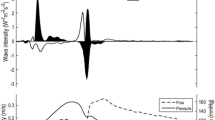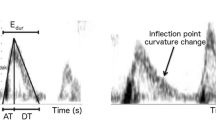Summary
In order to explore a new approach to the analysis of diastolic dysfunction, we adapted wave-intensity analysis (WIA), a time-domain analysis that provides information regarding both upstream and downstream events, to left ventricular (LV) filling. WIA considers the pressure and flow waves as summations of successive wavelets, characterised by the direction they travel and by the sign of the pressure gradient associated with them. Wave intensity is the product, dPdU, calculated from the incremental differences in LV pressure (dP) and mitral velocity (dU) and, during the diastolic filling interval, yields up to five dPdU peaks.Peak 1 is caused by backward-travelling expansion waves that accelerate the blood while LV pressure falls, and may be related to “diastolic suction”.Peak 2 is caused by forward-travelling compression waves which occur if acceleration continues after LV pressure begins to increase.Peak 3 is caused by backward compression waves and is associated with rising LV pressure and deceleration.Peak 4 is caused by forward compression waves and is associated with the increasing LV pressure and acceleration caused by atrial contraction.Peak 5 is caused by backward compression waves and is associated with increasing pressure and deceleration. These preliminary observations suggest that WIA can be useful in describing the mechanics of LV filling and, after much further work has been accomplished, it might prove useful in the detection and characterization of diastolic dysfunction.
Similar content being viewed by others
References
Parker KH, Jones CJH (1990) Forward and backward running waves in the arteries: Analysis using the method of characteristics. J Biomech Eng 112:322–326
Parker KH, Jones CJH, Dawson JR, Gibson DG (1988) What stops that flow of blood from the heart? Heart Vessels 4:241–245
Jones CJH, Sugawara M, Davies RH, Kondoh Y, Uchida K, Parker KH (1994) Arterial wave intensity: Physical meaning and physiological significance. In: Hosoda S, Yaginuma T, Sugawara M, Taylor MG, Caro CG (eds) Recent progress in cardiovascular mechanics. Harwood, Chur, Switzerland, pp 129–148
Jones CJH, Parker KH, Hughes R, Sheridan DJ (1992) Nonlinearity of human arterial pulse wave transmission. J Biomech Eng 114:10–14
Jones CJH, Sugawara M (1993) Wavefronts’ in the aorta — implications for the mechanisms of left ventricular ejection and aortic valve closure. Cardiovasc Res 27:1902–1905
Rushmer RF (1964) Initial ventricular impulse. A potential key for cardiac evaluation. Circulation 29:268–283
Euler L (1775) Principia pro moto sanguinis per arterias determinando. Anonymous Leonhardi Euleri Opera Omnia, ser. 2, vol. 16 (1979) Societatis Scientiarum Naturalium Helvetice, Berne, pp 178–196
Jones CHJ, Song GJ, Gibson DG (1991) An echocardiographic assessment of atrial mechanical behaviour. Br Heart J 65:31–36
Little WC, Badke FR, O’Rourke RA (1984) Effect of right ventricular pressure on the end-diastolic left ventricular pressure-volume relationship before and after chronic right ventricular pressure overload in dogs without pericardia. Circ Res 54:719–730
Ohno M, Cheng C-P, Little WC (1994) Mechanism of altered patterns of left ventricular filling during the development of congestive heart failure. Circulation 89:2241–2250
Cheng C, Freeman GL, Santamore WP, Constantinescu MS, Little WC (1990) Effect of loading conditions, contractile state, and heart rate on early diastolic left ventricular filling in conscious dogs. Circ Res 66:814–823
Katz LN (1930) The role played by the ventricular relaxation process in filling the ventricle. Am J Physiol 95:542–553
Tyberg JV, Keon WJ, Sonnenblick EH, Urschel CW (1970) Mechanics of ventricular diastole. Cardiovasc Res 4:423–428
Sabbah HN, Stein PD (1981) Negative diastolic pressure in the intact canine right ventricle. Evidence of diastolic suction. Circ Res 49:108–113
Ingels NB Jr, Fann JI, Daughters GT, Nikolic SD, Miller DC (1994) Left ventricular volume is not constant during “isovolumic” contraction and relaxation using standard LV models [abstract] Circulation 90:I-431
Salisbury PF, Cross CE, Rieben PA (1963) Chorda tendinea tension. Am J Physiol 205:385–392
Sovak M, Lynch PR, Stewart GH (1973) Movement of the mirtral valve and its correlation with the first heart sound. Selective valvular visualization and high-speed cineradiography in intact dogs. Invest. Radiol 8:150–155
Hawthorne EW (1961) Instantaneous dimensional changes of the left ventricle in dogs. Cir Res 9:110–119
Bove AA (1971) Radiographic evaluation of dynamic geometry of the left ventricle. J Appl Physiol 31:277–234
Tsakiris AG, Gordon DA, Padiyar R, Frechette D (1978) Relation of mitral valve opening and closure to left atrial and ventricular pressures in the intact dog. Am J Physiol Heart Circ Physiol 234:H146-H151
Altieri PI (1973) Left ventricular wall motion during the isovolumic relaxation period. Circulation 48:499–505
Ruttley MS, Adams DF, Cohn PF, Abrams HL (1974) Shape and volume changes during “isovolumetric relaxation” in normal and asynergic ventricles. Circulation 50:306–316
Thomas JD, Choong CYP, Flachskampf FA, Weyman AE (1990) Analysis of the early transmitral Doppler velocity curve: Effect of primary physiologic changes and compensatory preload adjustment. J Am Coll Cardiol 16:644–655
Nishimura RA, Abel MD, Hatle LK, Tajik AJ (1989) Assessment of diastolic function of the heart: Background and current applications of Doppler echocardiography. Part II. Clinical studies. Mayo Clin Proc 64:181–204
Brecher GA, Kissen AT (1957) Relation of negative intraventricular pressure to ventricular volume. Circ Res 5:157–162
Hori M, Yellin EL, Sonnenblick EH (1982) Left ventricular diastolic suction as a mechanism of ventricular filling. Jpn Circ J 46:124–129
Nikolic S, Yellin EL, Tamura K, Vetter H, Tamura T, Meisner JS, Frater RWM (1988) Passive properties of canine left ventricle: Diastolic stiffness and restoring forces. Circ Res 62:1210–1222
Suga H, Goto Y, Igarashi Y, Yamada O, Nozawa T, Yasumura Y (1986) Ventricular suction under zero source pressure for filling. Am J Physiol Heart Circ Physiol 251:H47-H55
Iwazumi T, ter Keurs HEDJ (1987) Mechanical properties of single cardiac myocytes and ultra-small trabeculae of rat [abstract]. Circulation 76:IV-331
Rushmer RF, Crystal DK, Wagner C (1953) The functional anatomy of ventricular contraction. Circ Res 1:162
Hui WKK, Gibson DG (1985) The dynamics of rapid left ventricular filling in man. Adv Cardiol 32:7–35
Hui WKK, Gibson DG (1983) Mechanisms of reduced left ventricular filling rate in coronary artery disease. Br Heart J 50:362–371
Courtois M, Kovacs SJ Jr, Ludbrook PA (1988) Transmitral pressure-flow velocity relation: Importance of regional pressure gradients in the left ventricle during diastole. Circulation 78:661–671
Little WC, Ohno M, Kitzman DW, Thomas JD, Cheng C-P (1995) Determination of left ventricular chamber stiffness from the time for deceleration of early left ventricular filling. Circulation 92:1933–1939
Tyberg JV, Smith ER (1990) Ventricular diastole and the role of the pericardium. Herz 15:354–361
Author information
Authors and Affiliations
Rights and permissions
About this article
Cite this article
MacRae, J.M., Sun, YH., Isaac, D.L. et al. Wave-intensity analysis: a new approach to left ventricular filling dynamics. Heart Vessels 12, 53–59 (1997). https://doi.org/10.1007/BF02820867
Received:
Accepted:
Issue Date:
DOI: https://doi.org/10.1007/BF02820867




